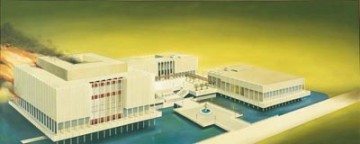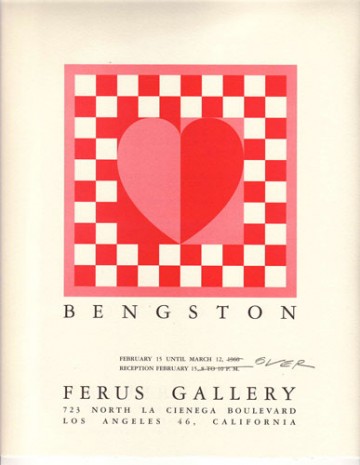
Ed Ruscha, "The Los Angeles County Museum on Fire," 1968, oil on canvas. Courtesy edruscha.com.
When I moved from Berkeley to Los Angeles five years ago, I thought I was done living in a town that was devoted to perpetually remembering the ’60s. But I soon discovered that Los Angeles also carries a mega-torch for that transformative decade. It’s easy to see why that era is appealing and continually inspiring these California cultural centers, respectively—it was during the 1960s that Berkeley distinguished itself as a hub of counter-cultural development and progressive action; meanwhile Los Angeles finally began to transcend its reputation as a vapid entertainment factory and, peeking out from under New York’s shadow, started to develop into prominent epicenter of contemporary art.
In her latest post, my co-columnist Catherine Wagley recounted how, during a recent panel discussion at LACMA, a young man asked what he should “take from” from art produced before his time. It just so happens that LACMA has good news for those of us who agree with Catherine’s conclusion that younger generations should make the most of things and “take as much as [they] possibly can” from the art of previous generations. This week, the 1960s art world became even easier to remember for those of us who weren’t really there (and even those of us who were). Two days before Steve Jobs introduced Apple’s slick Kindle rival, LACMA announced the creation of an online Reading Room–a virtual space in which the museum will present digital versions of LACMA’s publications. While the virtual Reading Room will eventually include more current books, their inaugural collection is exclusively comprised of out-of-print publications that focus on the Los Angeles art scene during the late 1960s (and late 1950s). Now, the iPad Generation can virtually experience catalogues from ten seminal exhibitions including Six Painters and the Object, Six More, Art in Los Angeles: Seventeen Artists in the Sixties, and Late Fifties at the Ferus.

Ed Moses, John Altoon, Billy Al Bengston, and Irving Blum, 1959. Claxton Photo, courtesy ferusgallery.com.
Speaking of which, the Ferus Gallery, which exhibited almost all of the artists currently featured in LACMA’s Reading Room, has been enjoying a major revival. Last weekend, in conjunction with Art Los Angeles Contemporary (yet another new LA Art Fair, this time held at the Pacific Design Center), New York dealers Tim Nye and Franklin Parrasch mounted an exhibition entitled Ferus Gallery: Greatest Hits Volume I, at the exact site of the original Ferus storefront gallery space at 736-A North La Cienega Boulevard, which has served as a tailor shop in the intervening decades. The exhibition featured Ferus veterans John Altoon, Larry Bell, Billy Al Bengston, Bruce Conner, Joseph Cornell, Jay DeFeo, Llyn Foulkes, Craig Kauffman, Ed Kienholz, Roy Lictenstein, Ed Moses, Ken Price, Ed Ruscha, and Andy Warhol. Word on the street is that Nye and Parrasch may take the show on the road, reprising it at The Armory Show this Spring.

Bengston Mailer at Ferus Gallery, courtesy Samuel Freeman Gallery.
For those of you who missed out on the seeing the old Ferus space in the flesh, you may have another shot at the uncanny pleasure of visiting a 2010 version of the famed gallery. On February 16, the public can experience yet another reprisal. Samuel Freeman Gallery (which occupies the former gallery space of Patricia Faure—another 1960s Los Angeles art legend) is building “a re-creation of the Ferus space (not exactly but close to scale),” within the walls of Samuel Freeman’s Santa Monica gallery, which is approximately eight times the size of the original Ferus Gallery. The exhibition, entitled Billy, will include many works from Billy All Bengston’s 1960 solo exhibition, held at Ferus Gallery exactly 50 years ago. In addition, viewers can expect to take in a survey of Bengston’s work from the intervening five decades mounted on the walls surrounding the Ferus replica, although “expect” would be the operative word. A spokesman from Samuel Freeman Gallery told the LA Times, “With Billy, you don’t know what you’re getting. He may show up two days beforehand with a totally different idea.” But one thing is certain: you’ll remember the ’60s.



